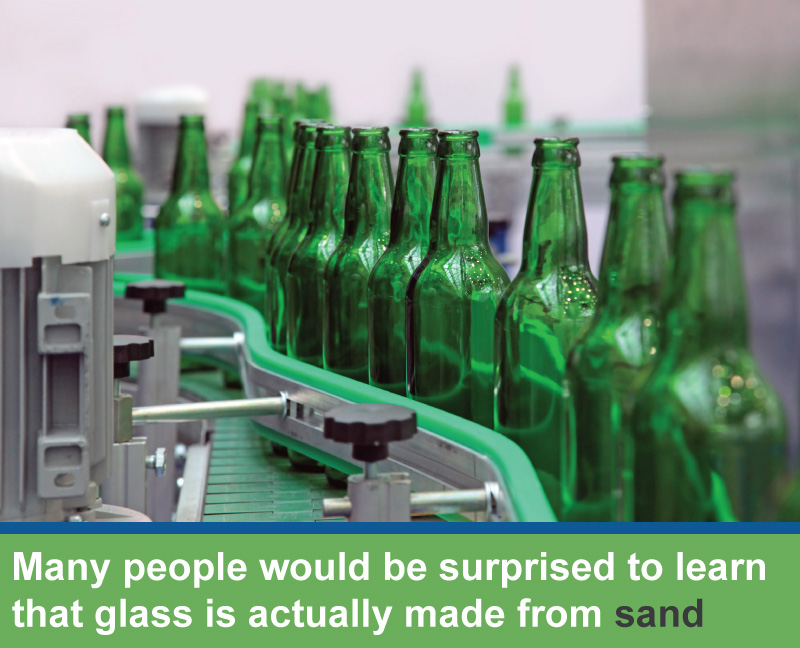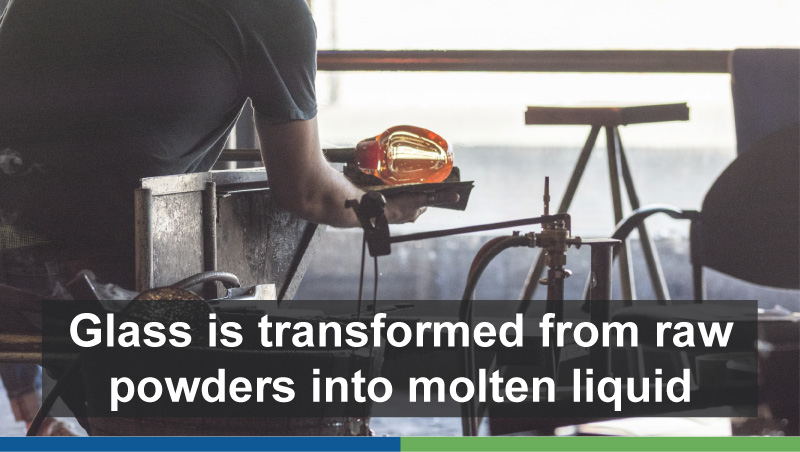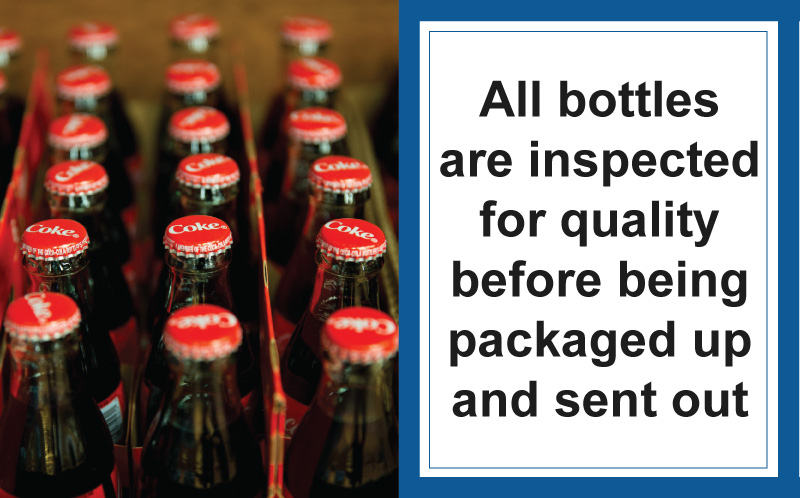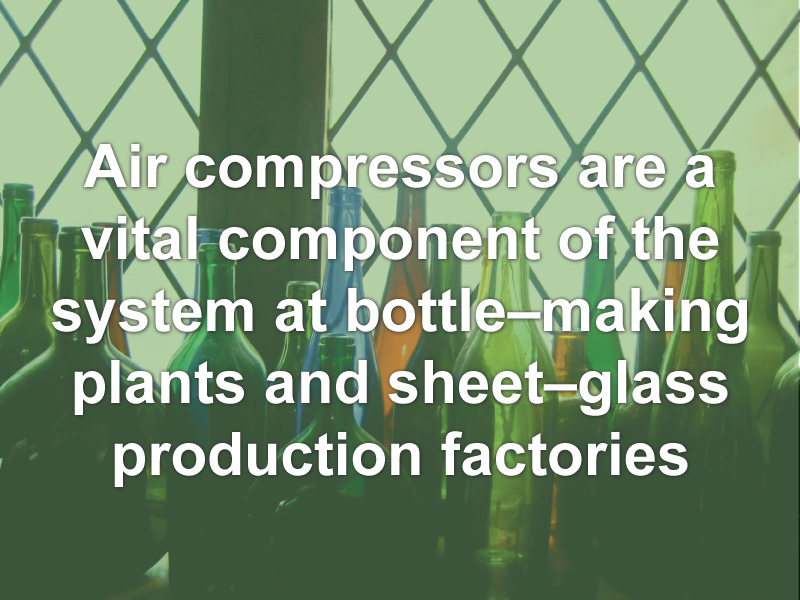Glass is one of the most widely used natural products in the world due to its strength and transparent quality, making it unique among architectural and packaging materials. Glass is also one of the most environmentally-friendly of all mass–manufactured products since it’s 100% recyclable and refillable. Glass is among the safest of products for storing consumable goods since it doesn’t contain hormone disruptors or carcinogens.
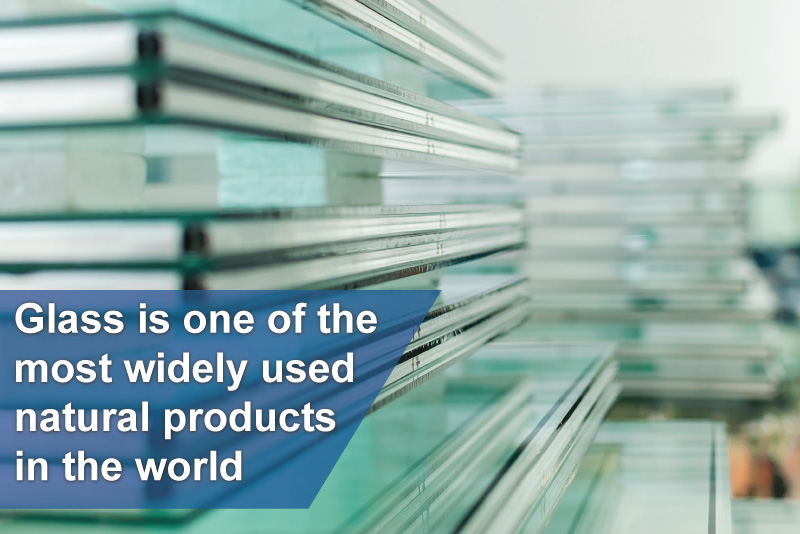
In terms of sanitation and shelf life, glass also has the power to protect a product from light. For everything from champagne to soft drinks, glass provides a perfect way to market products since inside a transparent glass bottle, high carbonation levels can be maintained over lengthy periods. Modern–day glass production would hardly be possible, however, without the compressed–air driven machinery used at the world’s leading glass manufacturing plants.
Contact Us Learn More Find a Dealer Near You
Compressed Air in Bottle Production
For the average consumer, the availability of glass bottles is generally taken for granted. Whether it’s a bottled soft drink or fine wine, the bottle is simply used and discarded with little thought for the series of processes that form glass from an initial set of raw materials. What many people are surprised to learn is that the solid, see-through material known as glass is made largely from sand.
The production of bottles can basically be divided into the following eights steps, which can take several days to complete as the glass is transformed from raw powders into molten liquid and finally into the clear, hardened containers that consumers recognize on their store shelves.
- The Collection of Raw Materials
The production of glass begins with a number of raw materials, mainly sand, limestone and soda ash. The first of these materials gives glass its strength and firmness, while the latter two work as softeners that makes glass easier to mold. These materials are moved from silos to furnaces via air–powered machinery.
Another ingredient used in the production of glass is cullet, the industry term for furnace–ready recycled glass. The use of cullet allows manufacturers to cut down on the volume of raw materials that would otherwise be needed for the mass production of bottles, jars and other containers. This, in turn, helps reduce the amount of greenhouse gas a glass–production factory might emit within a given year.
- Batching and Transfer
The raw materials used to make glass are first delivered to a batch house, where the materials are inspected for quality. The materials that pass are stored in silos, which are basically tall industrial towers that store many tons of bulk sand and limestone.
The silos serve as the holding place for the raw material until production officially commences with the hot phase of glass production. With the use of pneumatically powered machinery, weighed amounts of sand, limestone, soda ash and cullet are delivered to a furnace to be melted down and mixed into molten glass.
- Melting and Mixing
With an air–powered charger, raw material is fed from a silo into a furnace, where the glass ingredients are heated and stirred with a combustible mix of intensly hot gas and compressed air. Depending on the desired quality, style or color of the glass being produced, the balance of ingredients will differ slightly.
The melting process for a batch of molten glass can last for the better part of a day, during which time the mix is treated at temperatures that exceed those of an active volcano. Once the mix is ready to leave the furnace, it’s fed via air–driven conveyors into pneumatically powered formation machines.
- Feeding and Cutting
With the glass now thoroughly mixed into the proper chemical make up for what will ultimately be the finished product, the glass is forced with high air pressure through orifice rings, through which the glass takes on a cylinder shape.
Next, the glass is cut with shears into smaller pieces known as gobs, which are measured by weight and cut appropriately. Each gob contains the exact amount of mass for a single glass container. From here, the gobs are sent to a forming machine, where they will ultimately assume the shape of the final container.
- Forming Into Shape
Compressed air turns gobs into the shape of bottles inside the forming machines, where all the parts that comprise the bottle — the lip, collar, neck, stem, shoulder, body, in–sweep heel, cavity and raised embossing — are formed. It’s at this stage that the glass begins to look like the containers that will soon be shipped to stores everywhere.
The forming stage consists of several steps, with a series of pneumatic tools that work on the outside shape of the bottle and another tool that is used to form the inside cavity, into which a beverage will ultimately be sealed for consumption.
- Annealing the Surface
When a new glass container is formed, it dries on the outside sooner than it does within the cavity. Consequently, stresses along the glass can result from natural drying. Through a process known as annealing, the bottles are reheated for at least an hour and dried inside and out with compressed air. This creates evenness along the surfaces and helps ensure each bottle has the desired shape for the market.
- Coating the Surface
Once a bottle, jar or other type of container has taken shape, it’s sent along a conveyor and coated with a thin layer of tin. The purpose for tin here is to make the bottle harder and shinier along the surface. The glass is also treated with a thin layer of polymer, which gives each bottle a scratch–resistant surface.
Throughout these processes, pneumatic equipment powers conveyor belts, where bottles are moved along in single file with speed and efficiency as coatings are applied.
- Packaging the Bottles
Once the process of glass manufacturing has finished, all bottles are inspected for quality and conformity to form. Bottles that don’t meet these specifications are rejected and recycled. Afterwards, the readied bottles are packaged and sent to food and beverage packaging plants, where products such as brand-name colas, beers and wines are bottled.
Of course, once the bottles hit the conveyor belts at the packaging plants, a different set of air compressors and pneumatic tools are used to drive the process. Compressed air is used to power the machines that also fill the bottles, apply the caps and apply the product labels.
Compressed Air in Sheet Glass Manufacturing
The production of sheet glass is a more straightforward process than glass container manufacturing. The processes during the hot stages are much the same, but the cooled product simply needs to be dried flat and cut to specified dimensions, then shipped off to window factories. Basically, the process of sheet glass manufacturing can be broken down into the following five steps.
- The Main Ingredients
The process of sheet glass production begins high off the ground, inside large silos where sand is held in bulk quantities. On a daily basis, a select amount of sand is moved via air–powered machinery from the silos to an adjacent glass–making factory, where the sand is mixed with limestone and soda ash, which softens the glass and makes it easier to melt.
The mixed raw materials are funneled through a series of tank chambers that melt at temperatures hotter than lava. At modern factories, rotary compressors are used to create compressed air that will drive the conveyors that lead the mix from one chamber to the next. From here, it takes about three days to transform this molten material into glass.
- The Melting Stage
Inside the molten chambers, the glass mix is super–heated for more than ten hours. During this time, the glass can only be viewed at a distance through metal masks. Throughout the time that the glass is heated, gas is used to drive bubbles out of the mixture. Without this step, permanent bubbles could actually form within the finished sheets of glass, which would render it useless.
- Flattening With Liquid Tin
Arguably, the most remarkable stage in the production of sheet glass involves the transformation of the molten mix into the clear, perfectly flattened product that eventually finds use in the form of window panes. This process is carried out with the help of tin blocks, which are melted into liquid form and serve as a river on which the newly formed glass can dry and harden as it leaves the last melting chamber.
The secret here is that tin and glass don’t mix, which makes liquefied tin a perfect substance onto which glass can harden properly into flat, long sheets. Throughout this process, air–powered conveyor systems are used to move the glass along.
- The Cool Down
When sheet glass first comes out of the machine in its clear, flat, hardened state, it’s high temperature gives it a flexibility that makes it easy to manually wobble. Therefore, the glass must be brought down another hundred degrees to be readied for the cutting stage.
During the cooling process, compressed air is used to bring the temperature down to a level that renders the glass sheets firm and straight. With rotary air compressors, a glass production plant can power pneumatic blowers for utmost speed and efficiency.
- Cutting Into Slabs
The glass is then cut into slabs, which are lifted from the conveyor belt with pneumatic suction arms. The cut glass is then shipped off to window factories for further modification and distribution in the form of window panes of varying design.
Air Compressors for Glass Manufacturing
At bottle–making plants and sheet–glass production factories, air compressors are a vital component of the system that moves everything from the silos to the finishing stages. Air compressors drive the machinery that moves tons upon tons of raw materials to the mixing chambers and, from there, to the forming stages that produce unique bottles and slabs of glass.
Along the way, pneumatic tools are used to cool the glass to ideal temperatures and perform shaping and cutting, sheet by sheet or gob by gob.
One of Europe’s largest glass manufacturers is Saint-Gobain Oberland AG, which produces more than a million bottles daily at the company’s Wirges factory in Westerwald, Germany. Compressed air from rotary units are used through various stages of the glass–making process. This equipment allows the company to keep up its mass production scale while keeping energy costs down.
Thanks to the uncomplicated design of rotary compressors, which consist of few moving parts, the machines require nominal maintenance and have the power to operate at full capacity for several years.
The air compressors that drive productions at Saint-Gobain’s factories have recorded hundreds of thousands of operating hours with regular maintenance. The lion’s share of productivity at the company’s four factories in Germany is no doubt owed to the power of compressed air technology, which allows for glass production of glass on a mass scale that wouldn’t have been possible before the introduction of such machinery.
Glass Manufacturing Air Compressors From Quincy Compressor
Compressed air drives the manufacturing sector on all conceivable fronts. From the production of sheet glass and metals to more specific items like bottles, jars and containers, compressed air is utilized to drive along the conveyor systems that move the materials through the mixing process and ultimately through to the finishing stages.
For nearly a century, Quincy Compressor has been among the world’s leading makers of air compressors for glass manufacturing and numerous other industries. Since the 1920s, Quincy has developed compressors that provide air power to the factory machinery that produces everything from bottles, jars, bowls and plates to the slabs of glass that are used for windows in houses, buildings and automobiles across the globe.
At Quincy, we manufacture rotary screw air compressors and vacuum pumps that have the power to drive the processes necessary for glass production in mass volumes. The optimal efficiency of our rotary screw compressors makes these machines easy to operate and maintain.
Today, the demands placed on the glass industry are more grueling than ever. With products needed by millions on a day–to–day global scale, glass plants need machinery that can drive the whole production process from start to finish. At factories around the world, compressed air in glass manufacturing is possible with the use of Quincy compressors.
To learn more about our air compressors for glass manufacturing, click over to our sales and services locator to find a local authorized provider.


